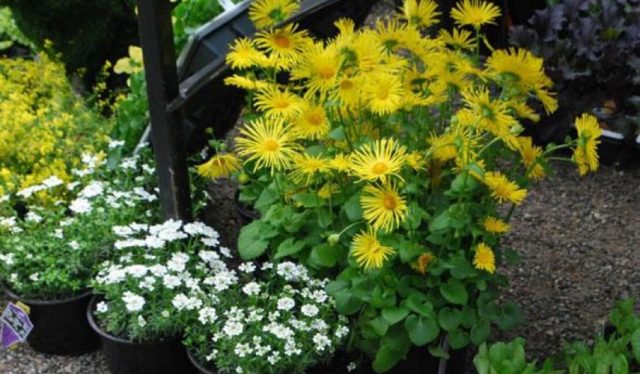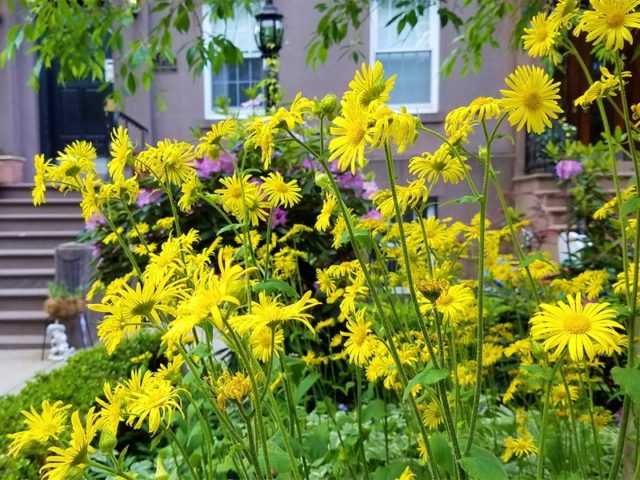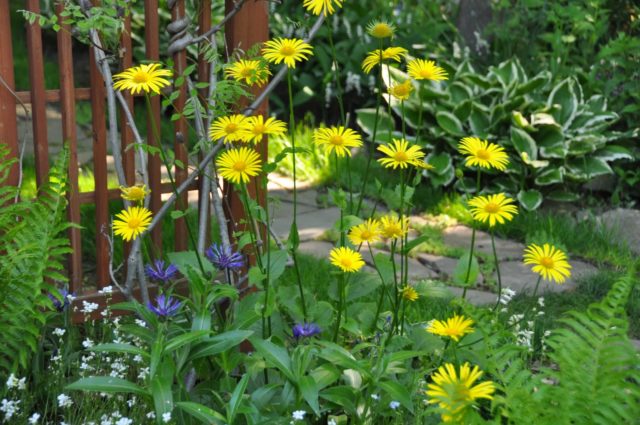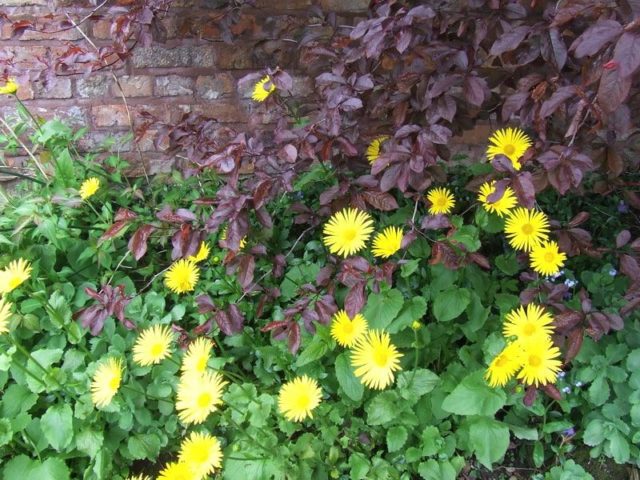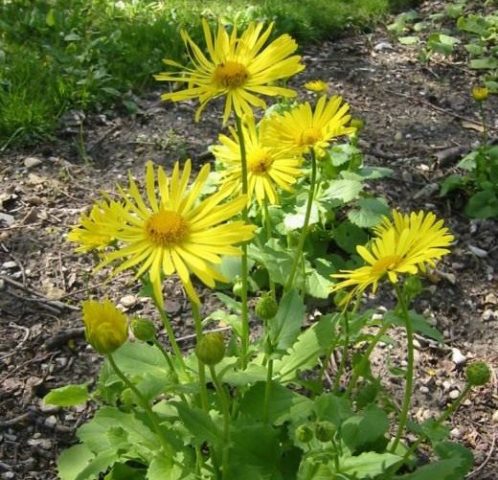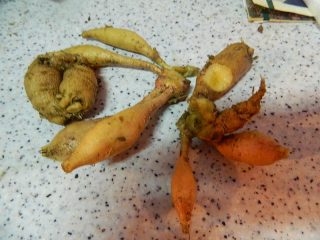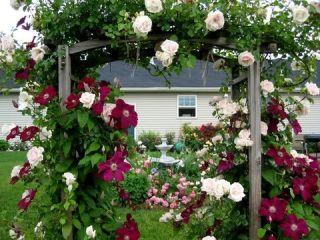Content
- 1 Description and characteristics
- 2 Types of flowers Doronikum
- 2.1 Doronicum austrian (doronicum austriacum)
- 2.2 Doronicum oriental (doronicum orientale)
- 2.3 Doronicum Altai (doronicum altaicum)
- 2.4 Doronicum Columnae
- 2.5 Doronicum Clusa
- 2.6 Doronicum plantagineum
- 2.7 Doronicum oblongifolium
- 2.8 Doronicum turkestan (doronicum turkestanicum)
- 2.9 Doronicum Caucasian (doronicum caucasicum)
- 3 Reproduction methods of perennial Doronikum
- 4 Planting and caring for Doronicum
- 5 Diseases and pests of the Doronicum plant
- 6 Doronicum perennial in landscape design
- 7 Conclusion
The doronicum flower is a large yellow chamomile that flaunts against the background of bright green foliage. Looks great both in single landings and in compositions. Does not require frequent feeding, only needs regular watering. Therefore, every grower can grow these pleasant bushes.
Description and characteristics
Doronicum (doronicum) is a perennial flowering plant from the genus of the same name, belongs to the Astrov family. Under natural conditions, it is ubiquitous in the foothills and mountains (up to 3500 m) of the temperate climatic climate of Eurasia and partly in the countries of North Africa.
Doronicum is also called yellow chamomile, because in appearance it really resembles this flower (the shape of the petals and stamens). Another synonym is goat.
A small bush - an average of 30 to 100 cm (depending on the specific species or variety). Quite sprawling in width - reaches 40-50 cm, sometimes more. Shoots are erect, weakly branching. The leaves are of a pleasant green hue, heart-shaped, rather wide (5-6 cm), arranged alternately.
At the base of the root is a root rosette of leaves with particularly long cuttings. Often, slight pubescence is noticeable on shoots and foliage. The root system is shallow, so the goat needs frequent watering.
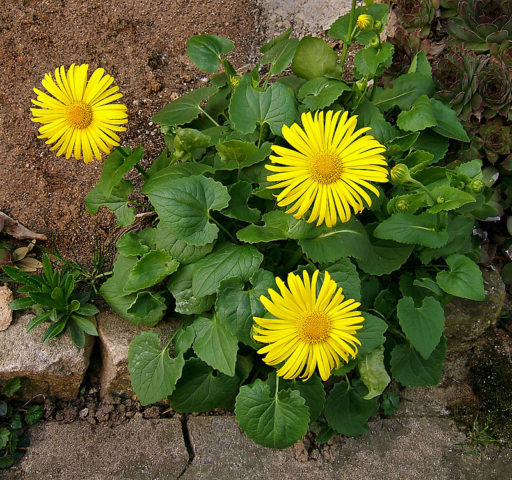
The yellow flowers of the goat are very attractive against the background of green foliage.
Doronicum forms flower baskets of rich yellow color, the core is orange, closer to light brown. They are large in size - in diameter they can reach from 5 to 12 cm (although they are smaller, it all depends on the species). Consist of 1 or 2 rows of narrow, elongated petals. The flowering period also depends on the species - it can start in May, June and even April (generally lasts 4 to 6 weeks). Flowers are combined into corymbose inflorescences.
After flowering, the brown achenes ripen, reaching a length of only 3 mm. Inside these can be found some very small seeds that can be collected and stored at home. They will emerge not only in the next season, but also in 2 years.
Types of flowers Doronikum
There are about 40 plant species in the Doronicum genus, many of which are used in garden design. Popular types of goat with a photo are described below.
Doronicum austrian (doronicum austriacum)
Quite tall bush (up to 70 cm) with straight stems. Leaf blades are ovoid, inflorescences up to 5 cm wide. This type of doronicum is native to the Mediterranean countries. For a long time it has been cultivated in Austria, due to which it received the corresponding name.

The flowers of the Austrian doronicum are bright yellow, with dissected petals
Doronicum oriental (doronicum orientale)
This type of goat is a short (up to 0.5 m high) and compact (up to 0.4 m wide) bush. Shoots are straight, without branching, leaves of a rich green color, planted on long petioles. The shape is ovoid, oval. Doronicum oriental blooms for 4-6 weeks - from June to July.
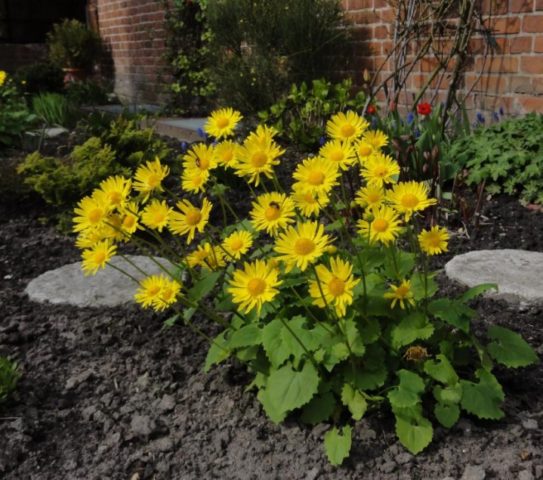
The doronicum bush produces many bright yellow flowers up to 5 cm in diameter
Doronicum Altai (doronicum altaicum)
This type of goat can be of various sizes - from 10 to 70 cm in height. The stems are purple, red, and even brown. There are few foliage, the peduncles are noticeably higher than the main part of the doronicum. Inflorescences up to 6 cm wide.
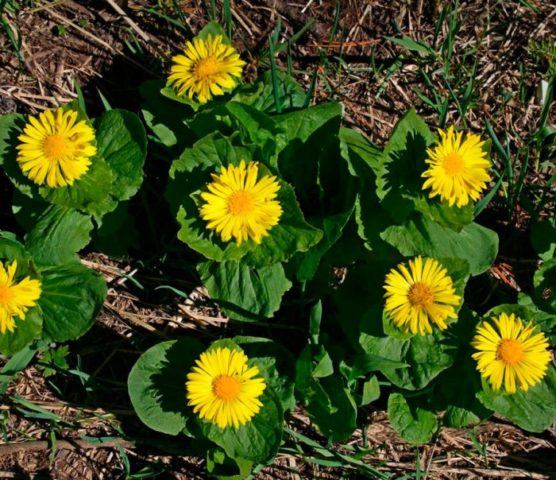
Fluffy flowers of the Altai culture look great against the background of large oval leaves
Doronicum Columnae
This type of doronicum reaches 40 to 80 cm in height. Flowers - yellow daisies up to 6 cm in diameter. Peduncles are naked, stems are branched, so the whole bush is covered with beautiful inflorescences.
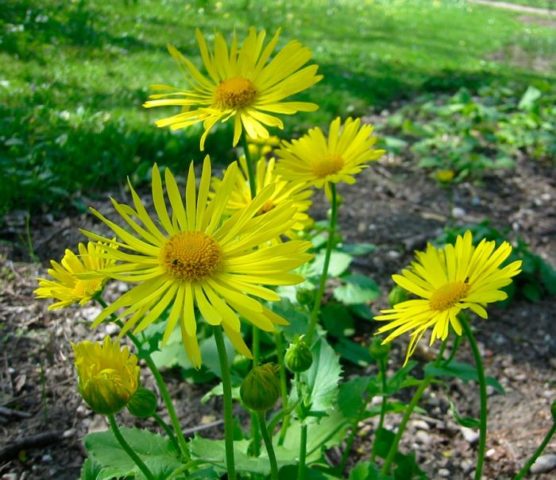
The color of the flowers of the Colonna variety is closer to lemon yellow
Doronicum Clusa
The original species of Clusa's goat (doronicum clusii) is a miniature bush up to 30 cm in height. Leaves are rich green, elongated, single flowers, bright yellow shade. In nature, it is found in the foothills of the Alps, so in the garden it will look especially beautiful in rocky slides and rock gardens.
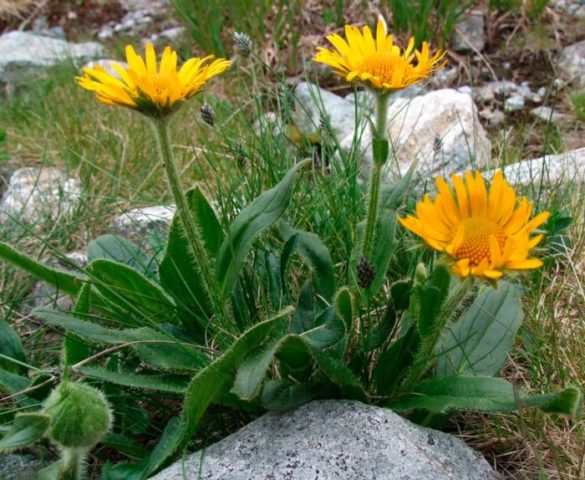
The flowers of the Kluz variety are bright yellow, closer to light orange
Doronicum plantagineum
This type of goat is distinguished by very large peduncles - up to 140 cm and large flowers from 8 to 12 cm.Includes 2 popular varieties:
- Excelsium (Excelsium) is a large goat shrub up to 1.5 m tall with yellow flowers reaching 10 cm in diameter.
- Mrs. Maison (Mrs. Mason) is a miniature plant. Its height does not exceed 60 cm.
Mrs. Mason's Doronicum leaves somewhat resemble a plantain
Doronicum oblongifolium
This type of goat is represented by miniature bushes from 10 to 50 cm in height. The peduncle is high, the flowers are large enough - up to 5 cm in diameter.
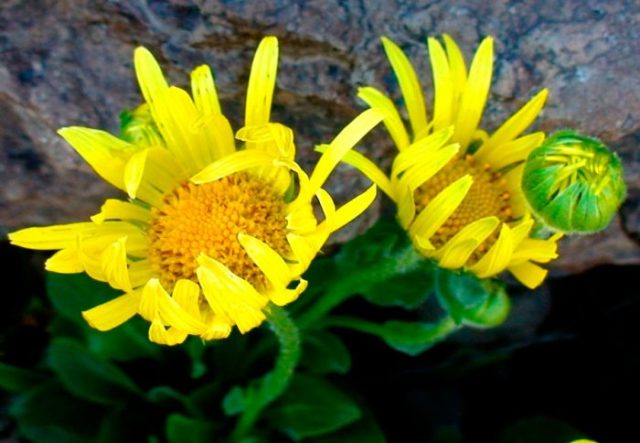
Doronicum oblong got its name from elongated leaves with pointed ends
Doronicum turkestan (doronicum turkestanicum)
A type of medium-sized goat, growing up to 70-75 cm in height. Despite its name, it is also found in Kazakhstan and Siberia, and has a high winter hardiness.
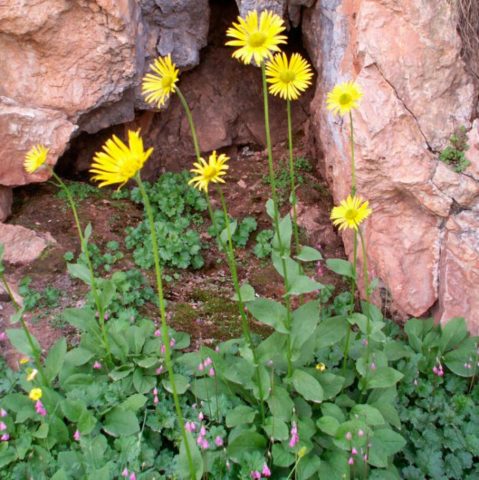
The flowers of the Turkestan goat are medium in size, up to 4 cm in diameter
Doronicum Caucasian (doronicum caucasicum)
The Caucasian variety is represented by medium-sized bushes up to 0.3-0.5 m in height. Flowering begins in mid-May and lasts over a month.
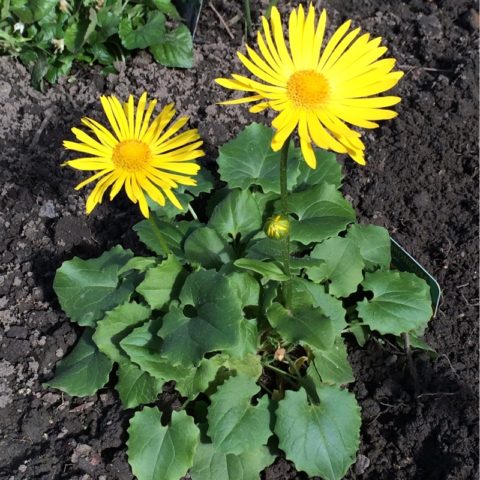
The leaves of the goat are cordate, with jagged edges.
Reproduction methods of perennial Doronikum
The goat can be grown from seeds at home or propagated by dividing an adult bush (aged 3-4 years and older). Despite the laboriousness, the first method is the most reliable. Although it is still necessary to divide the doronicum bush, and it is advisable to do this at least once every 4 years. This allows you to rejuvenate the bush by stimulating the development of new shoots.
Growing Doronicum from seeds
Goat seeds can be planted:
- For seedlings - in the first half of April.
- Directly into the ground - at the end of May or in the middle of October.
For cultivation, use a universal soil for seedlings or their own mixture, made up of coarse sand and peat, mixed in equal amounts. It is most convenient to take cassettes and plant 2-3 seeds in one cell. Doronicum grains are simply laid on the surface and lightly sprinkled with soil, after which they are moistened with a spray bottle, covered with a lid and placed in a warm place (25 ° C). In this case, the light needs to be bright enough, albeit diffused.
The first shoots of the goat goat appear in 1.5-2 weeks.After the seedlings reach a height of 4 cm, one bush is left in each cell, and the rest (weaker, lagging in development) are cut at the root (you do not need to pull them out). After the appearance of 3-4 leaves, the lateral shoots are pinched so that the future doronicum bush is formed lush.
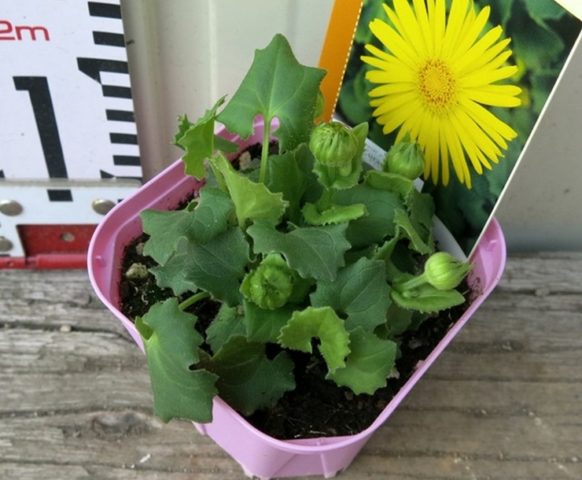
Doronicum seedlings can be grown in any containers, including plastic pots
Dividing the bush
Another way of reproduction of doronicum is by dividing the bush. This is a simple method that is used at the end of September, after the rosettes have grown. The goat bush is dug out with a sharp shovel, then gently shaken off and divided into several parts.
At the same time, at least 2-3 healthy shoots should remain at each delenka. They are planted in a permanent place, buried, and then a layer of mulch (peat, humus, dry foliage or other materials) is laid.
Planting and caring for Doronicum
Doronicum care is reduced to regular watering and loosening of the soil. If fertilizers were applied during planting in the pit, new fertilizing will be needed only in the next season.
When to plant Doronicum
Despite the fact that doronicum is a cold-resistant plant, young seedlings are transferred to the ground only at the end of May or even at the beginning of June, when the frosts will definitely not return (in the south it is possible in the first half of May). It is better to divide the bush in mid-September, about a month before the first noticeable cold snap (below + 5-10 ° C).
Site and soil preparation
Doronicum loves moderate light, so for planting it is better to choose a slightly shaded area, for example, not far from tall shrubs and garden trees. It is desirable that the site is slightly elevated (to prevent moisture accumulation and root rot) and protected from strong winds.
Before planting the goat, the site must be dug up to half the bayonet of the shovel and 1-2 kg of manure must be added for each 1 m2, or it must be repaired in the planting pits. This is especially important if the soil is not fertile.
Landing in open ground
The sequence of actions for planting doronicum:
- Several shallow pits are formed (according to the size of the rhizome) at a distance of at least 40-50 cm from each other - in this case, the planting will be tight, it can be done less often.
- Lay a small layer of small stones on the bottom (for drainage).
- Seedlings are rooted and sprinkled with fertile soil or a mixture of garden soil with peat and manure (2: 1: 1).
- Water abundantly.
- Mulch with straw, wood chips, peat or other materials.
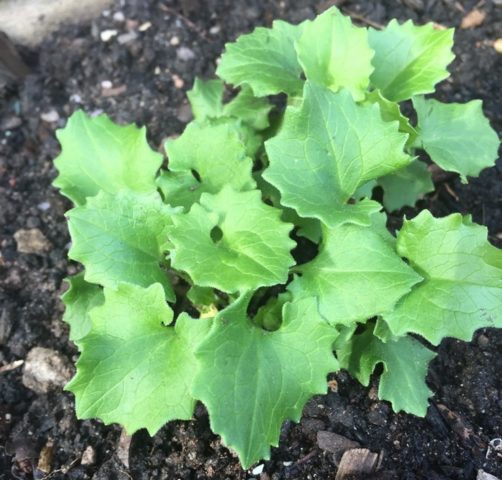
It is better to plant the goat in the garden at the end of May or at the beginning of June.
Follow-up care
In the future, caring for the doronicum includes the following actions:
- Watering regularly, but not excessive (the soil should remain slightly damp).
- Loosening is best done after each watering. This must be done very carefully, since the roots of the goat are very close to the surface.
- Every year in April, any organic or complex mineral fertilizer is applied - this will be enough.
- Mulching with cut grass, peat, sawdust. The layer needs to be updated periodically.
- In September or October, all peduncles and stems are cut at the root, leaving hemp 4-5 cm high. In regions with severe winters, the goat is covered with dry foliage, hay, and straw. The layer is removed in early spring.
- The transplant and division of the bush is carried out every 3-4 years.
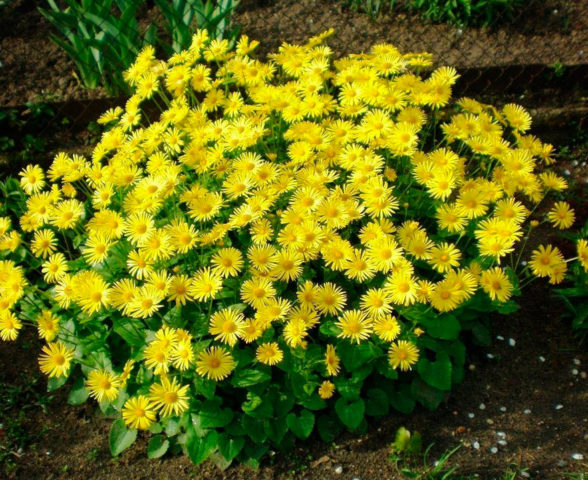
For the lush flowering of the goat, it needs to be watered regularly and occasionally fed.
Diseases and pests of the Doronicum plant
With improper care (excessive moisture), as well as in unfavorable, too rainy weather, the goat can suffer from various diseases:
- gray rot;
- rust;
- powdery mildew.
Therefore, as a preventive measure, plants should be treated with any fungicide in April:
- "Maksim";
- Fitosporin;
- "Speed";
- "Ordan";
- bordeaux liquid.
Also, aphids and thrips often settle on the leaves and stems of doronicum. They feed on the sap of the plant, which is why the flowers begin to deform and die off. To cope with it is quite simple - it is necessary to carry out treatment with insecticides:
- Actellik;
- Akarin;
- "Decis";
- "Karbofos";
- "Agravertin";
- "Fufanon".
Doronicum perennial in landscape design
Doronicum enlivens the garden with bright sunny daisies abundantly covering the miniature bushes. The plant can decorate remote, nondescript parts of the garden (including hiding old buildings), and not only in single plantings, but also in compositions with other flowers:
- primroses;
- daffodils;
- irises;
- tulips.
Below are some interesting options for using a goat in garden design:
- Single landing near the entrance.
- Goat next to the fence, in composition with fern and cornflowers.
- Landing next to the old fence.
- Rocky hill with doronicum.
- Multi-tiered composition with goat and other flowers.
- Doronicum in a single planting on a nondescript site.
Conclusion
Doronicum flower is one of the simplest and most proven ways to revitalize the garden, giving it spring freshness. Yellow inflorescences appear at the end of April. With proper care, there is often a second wave of flowering - it occurs at the beginning of August. Kozulnik will easily fit into the design of any garden, decorating the central parts and far corners.
